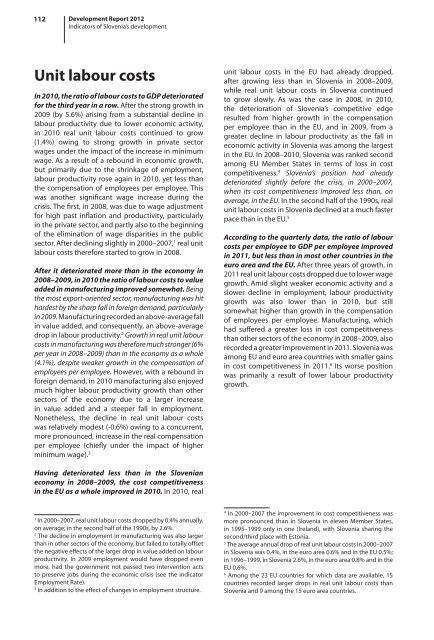development report 2012 - UMAR
development report 2012 - UMAR
development report 2012 - UMAR
Create successful ePaper yourself
Turn your PDF publications into a flip-book with our unique Google optimized e-Paper software.
112 Development Report <strong>2012</strong><br />
Indicators of Slovenia’s <strong>development</strong><br />
Unit labour costs<br />
In 2010, the ratio of labour costs to GDP deteriorated<br />
for the third year in a row. After the strong growth in<br />
2009 (by 5.6%) arising from a substantial decline in<br />
labour productivity due to lower economic activity,<br />
in 2010 real unit labour costs continued to grow<br />
(1.4%) owing to strong growth in private sector<br />
wages under the impact of the increase in minimum<br />
wage. As a result of a rebound in economic growth,<br />
but primarily due to the shrinkage of employment,<br />
labour productivity rose again in 2010, yet less than<br />
the compensation of employees per employee. This<br />
was another significant wage increase during the<br />
crisis. The first, in 2008, was due to wage adjustment<br />
for high past inflation and productivity, particularly<br />
in the private sector, and partly also to the beginning<br />
of the elimination of wage disparities in the public<br />
sector. After declining slightly in 2000–2007, 1 real unit<br />
labour costs therefore started to grow in 2008.<br />
After it deteriorated more than in the economy in<br />
2008–2009, in 2010 the ratio of labour costs to value<br />
added in manufacturing improved somewhat. Being<br />
the most export-oriented sector, manufacturing was hit<br />
hardest by the sharp fall in foreign demand, particularly<br />
in 2009. Manufacturing recorded an above-average fall<br />
in value added, and consequently, an above-average<br />
drop in labour productivity. 2 Growth in real unit labour<br />
costs in manufacturing was therefore much stronger (6%<br />
per year in 2008–2009) than in the economy as a whole<br />
(4.1%), despite weaker growth in the compensation of<br />
employees per employee. However, with a rebound in<br />
foreign demand, in 2010 manufacturing also enjoyed<br />
much higher labour productivity growth than other<br />
sectors of the economy due to a larger increase<br />
in value added and a steeper fall in employment.<br />
Nonetheless, the decline in real unit labour costs<br />
was relatively modest (-0.6%) owing to a concurrent,<br />
more pronounced, increase in the real compensation<br />
per employee (chiefly under the impact of higher<br />
minimum wage). 3<br />
unit labour costs in the EU had already dropped,<br />
after growing less than in Slovenia in 2008–2009,<br />
while real unit labour costs in Slovenia continued<br />
to grow slowly. As was the case in 2008, in 2010,<br />
the deterioration of Slovenia’s competitive edge<br />
resulted from higher growth in the compensation<br />
per employee than in the EU, and in 2009, from a<br />
greater decline in labour productivity as the fall in<br />
economic activity in Slovenia was among the largest<br />
in the EU. In 2008 –2010, Slovenia was ranked second<br />
among EU Member States in terms of loss in cost<br />
competitiveness. 4 Slovenia’s position had already<br />
deteriorated slightly before the crisis, in 2000–2007,<br />
when its cost competitiveness improved less than, on<br />
average, in the EU. In the second half of the 1990s, real<br />
unit labour costs in Slovenia declined at a much faster<br />
pace than in the EU. 5<br />
According to the quarterly data, the ratio of labour<br />
costs per employee to GDP per employee improved<br />
in 2011, but less than in most other countries in the<br />
euro area and the EU. After three years of growth, in<br />
2011 real unit labour costs dropped due to lower wage<br />
growth. Amid slight weaker economic activity and a<br />
slower decline in employment, labour productivity<br />
growth was also lower than in 2010, but still<br />
somewhat higher than growth in the compensation<br />
of employees per employee. Manufacturing, which<br />
had suffered a greater loss in cost competitiveness<br />
than other sectors of the economy in 2008–2009, also<br />
recorded a greater improvement in 2011. Slovenia was<br />
among EU and euro area countries with smaller gains<br />
in cost competitiveness in 2011. 6 Its worse position<br />
was primarily a result of lower labour productivity<br />
growth.<br />
Having deteriorated less than in the Slovenian<br />
economy in 2008–2009, the cost competitiveness<br />
in the EU as a whole improved in 2010. In 2010, real<br />
1<br />
In 2000–2007, real unit labour costs dropped by 0.4% annually,<br />
on average; in the second half of the 1990s, by 2.6%.<br />
2<br />
The decline in employment in manufacturing was also larger<br />
than in other sectors of the economy, but failed to totally offset<br />
the negative effects of the larger drop in value added on labour<br />
productivity. In 2009 employment would have dropped even<br />
more, had the government not passed two intervention acts<br />
to preserve jobs during the economic crisis (see the indicator<br />
Employment Rate).<br />
3<br />
In addition to the effect of changes in employment structure.<br />
4<br />
In 2000–2007 the improvement in cost competitiveness was<br />
more pronounced than in Slovenia in eleven Member States,<br />
in 1995–1999 only in one (Ireland), with Slovenia sharing the<br />
second/third place with Estonia.<br />
5<br />
The average annual drop of real unit labour costs in 2000–2007<br />
in Slovenia was 0.4%, in the euro area 0.6% and in the EU 0.5%;<br />
in 1996–1999, in Slovenia 2.6%, in the euro area 0.8% and in the<br />
EU 0.6%.<br />
6<br />
Among the 23 EU countries for which data are available, 15<br />
countries recorded larger drops in real unit labour costs than<br />
Slovenia and 9 among the 15 euro area countries.
















